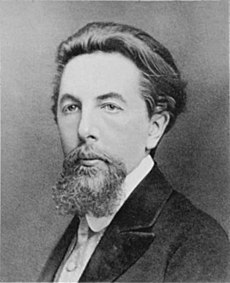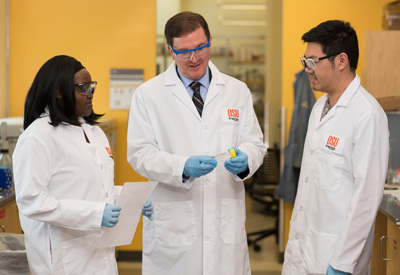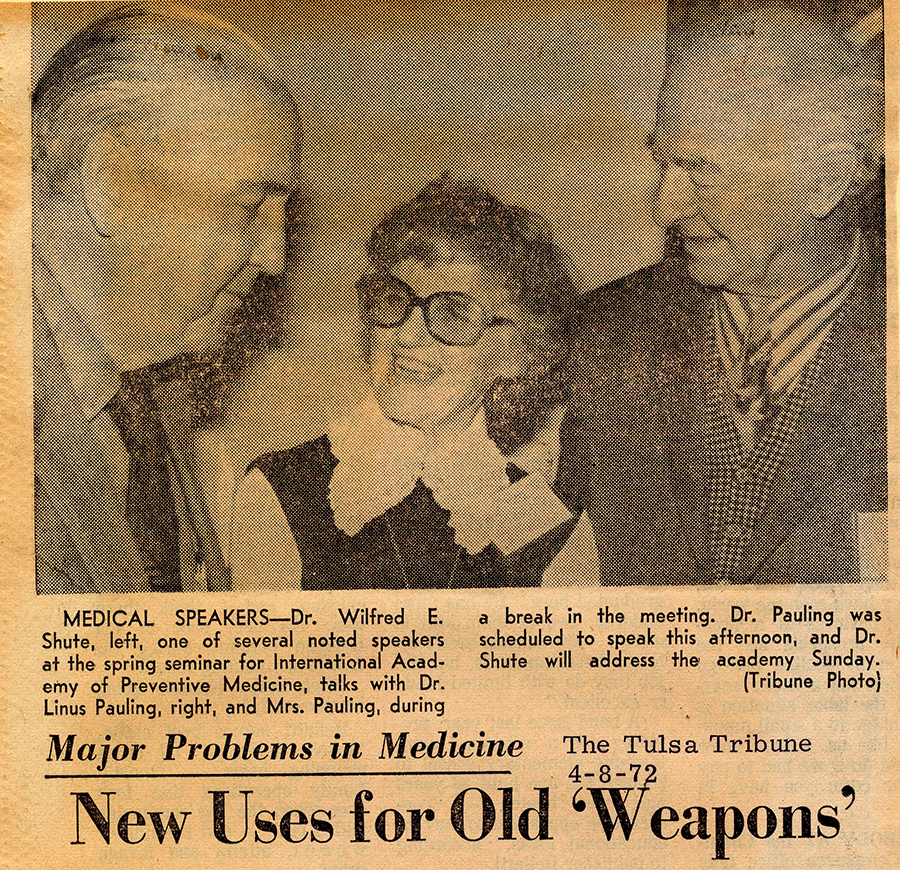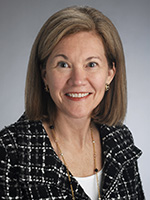
[In part 2 of our interview with Linus Pauling Institute Director Richard van Breemen, we trace the evolution of his career in scientific research, first at North Carolina State University and later at the University of Illinois, Chicago. This transcript has been lightly edited for clarity and continuity.]
Pauling Blog: Was North Carolina State your first faculty position?
Richard van Breemen: I did a post-doctoral fellowship for a year at Johns Hopkins, with Robert Cotter, then moved immediately into a faculty positon, yes. So I was an assistant professor at North Carolina State in the Chemistry department.
PB: And you founded the Mass Spectrometry Lab for Biotechnology at NC State, is that correct?
RVB: That was the attraction. I was offered a position with a very appealing start-up package that would enable me to buy a state-of-the-art, high-resolution, high-performance mass spectrometer. As I mentioned [in part 1], this revolution had occurred in the 1980s which enabled us to ionize molecules much larger than anyone had ever imagined, and so this was a time when we were starting to look at peptides, various small proteins, oligonucleotides, expanding beyond the volatile compounds that had dominated organic chemistry and mass spectrometry up until that time.
Mass spectrometers were very adept at looking at anything that could be distilled as gas phase molecules, things that could be changed from a condensed phase to a gas phase, because ultimately you have to put them into a vacuum. The ions are formed and then the ions have to be manipulated in weight in that vacuum so they don’t contact any air or any molecules that could quench the ions. But no one had succeeded in changing very polar large molecules – like sugars, DNA, proteins, RNA – from that condensed phase into the gas phase. It was just not considered possible. So my interest in the North Carolina State job was to start a mass spectrometry center and apply it to biotechnology questions.
Well, we could now, for some of the first times ever, use mass spectrometry to look at large protein-like molecules in ways that we never could before and answer some interesting questions in the biotech world. I had written a grant proposal to the NIH to use mass spectrometry to help determine protein structures, whereby we would cleave the proteins into smaller pieces with trypsin, chymotrypsin and other endoproteases, and then measure those smaller pieces by mass spectrometry, and then put them all back together again to determine what the structure of that protein had been and if there were any changes in it, post-translational modifications, or maybe it got modified by a pharmaceutical agent or a toxin.
And the critique – I keep all of the old critiques which I get from my grant proposals, I have a file for them. We used to call them Pink Sheets, because the NIH would mail you pink carbon copies of the type-written critiques of your grant applications, and you always shuddered when the mail came and you knew that letter was there, and you didn’t want to open it because you didn’t know what the answer was.
This one said that mass spectrometers were incapable of measuring large molecules, and it was absolutely impossible for anyone to even think that mass spectrometry could be applied to the study of whole proteins. Today, we call that field proteomics. I didn’t pursue proteomics beyond about 1990-91, and by the time I left NC State to go to Chicago, I was looking at much more biomedical problems.
PB: So was that the prompt to move to Chicago, this new shift in your interests?
RVB: Well, partly. I abandoned the idea of what was to become proteomics and peptide-based therapies and protein-based therapies, which is something that I’d been very interested in for a while, and started to pursue something that some of my colleagues at NC State had originally suggested.
So in the Biotechnology program, I got to meet a lot of folks involved in botany, food science, forestry, all these departments that are found at state universities around the country. And some of these colleagues brought me interesting research problems which I just found quite intriguing and pursued in one way or another to this day.

Mikhail Tsvet
One of my friends in food science, Steve Schwartz, brought me a set of carotenoids that he had purified by chromatography. Carotenoids and chromatography go all the way back to the beginning of chromatography, over a hundred years ago, when a Russian chemist, Mikhail Tsvet, found that he could take a glass column, fill it with diatomaceous earth and other solid-phase sorbents, pour an organic chemical solution – an extract from a plant – through it, and he would see bands as the liquids percolated through the column. He would see bands of color appear, and the bands would be chlorophylls and carotenoids.
So my colleagues in botany and food science brought me carotenoids and chlorophylls, and asked if I could determine their structures by mass spectrometry, which actually was fairly novel at the time. And so I had the tools – a very nice, high-performance tandem mass spectrometer, with absorption techniques, which enabled these molecules that really had been difficult with earlier mass spectrometry tools to ionize. I could ionize them with tandem mass spectrometry, which is literally: make the ion, break it into pieces in the gas phase, then measure the pieces with the next phase of mass spectrometry. You learn a lot about structure that way. I was able to get some very useful data for both chlorophyll identification and carotenoid identification. And that is where, at least in the carotenoid field, that I continued later.
There’s some other interesting stories of botanists. Wendy Boss came with a problem about signal transduction. Phosphatidylcholine, inositol, and other phospholipids were known to be messengers between human cells. She was asking the question, do plants also use these second messengers? Like phosphatidylinositols – P.I. – phosphoralated versions – PIP – and so on. And so I’ve collaborated with Wendy Boss for a while and helped establish that yes, some of the very same second messenger communications with phosphatidylinositols occur within plants – in particular, we used carrot cells – as happen in animals and humans.
So I moved out of the area of more biotechnology orientation towards more biomedical work, and then it was time for a change. I needed to be in a more biomedical environment, and an opportunity arose to move to Chicago to join a department in a Pharmacy school. I was trained in pharmacology, not strictly pharmacy, so I knew a lot about drug metabolism and receptors, and how drugs work, and a lot about mass spectrometry and looking at drug metabolism.
I joined a team there which had a long history and was one of the best pharmacognosy groups in the world. Pharmacognosy is an old name from the 19th century about the study of medicinal natural products from sources like plants, microbes; terrestrial or marine. And they needed somebody with my expertise who could use mass spectrometry to help them more quickly and efficiently identify new products that they were isolating, but also somebody who could help translate their discoveries into more of a biomedical application, towards the path of drug discovery. I joined a team lead by John Pizzuto, who was my department head at that time, who had been leading an NIH-funded center for natural products drug discovery; he called it “natural cancer prevention.” So these compounds that he envisioned would be useful in preventing the occurrence of disease and, in particular, cancer.
I remember the days when going to the doctor for an annual checkup wasn’t covered by insurance, because you weren’t sick, but the doctors had to check a box off to say that they were treating you for a cold or a throat infection or something, just so you could get health insurance to cover it. Those were the days before health insurance folks realized that – it’s the old Ben Franklin adage, “prevention is worth a pound of cure,” was true. It’s a lot cheaper to prevent cancer than to cure it. So today, I think, when health insurance does cover routine visits, it’s for annual checkups for the prevention of various forms of disease. But this was still an unappreciated, almost radical idea, even as recent as the 1990s.
So John Pizzuto had a program project grant from the NIH to screen, initially, botanical natural products – and later also marine natural products – for possible cancer prevention agents. And I helped identify those agents and then looked at their metabolism, bio-availability, pharmacokinetics; I started to move them towards clinical trial. And that group discovered molecules like resveratrol, which today are very famous as cancer prevention agents. Towards the end of the 1990s, I was still working as part of that team, but now it was time for me to start organizing some group efforts of my own.

Van Breemen in his laboratory at UIC.
PB: Can you tell me about that phase of your work, from 1999 to 2017, the research that was being done?
RVB: As the very first botanical center funded by the NIH to look at the safety and efficacy of these products, we decided to focus on women’s health, because women were, and continue to be, the main consumers of botanical dietary supplements. If not for themselves, they sometimes buy these supplements for children and for the household, so they’re the main consumers. But as is evident from the NIH initiatives recently, women have been understudied in clinical trials, they’ve been understudied in the drug development programs. And historically – and not everyone who consumes dietary supplements are uniform, middle-aged, or young men, but basically those are the folks for whom these products were initially developed
So we focused on women’s health, and instead of trying to go to the jungles of the world or the oceans of the world to find new supplements that might be safe and effective, we have focused exclusively on dietary supplements that have already been used or are currently on the market. We look at the evidence for use, historical use, in the literature and in natural medicine – the ethnobotanical history of these products – and of course their current use in products that are on the market. So our first goal in this program is to make sure that the products that are being used by women are safe. And as funding permits, we carry our clinical trials to investigate their efficacy.
But at all times we investigate mechanisms of action; we want to identify the active compounds and figure out how to standardize these products to make them more reproducible. That’s the essence of science: to understand why something is happening but do it in such a way that, when you carry out an experiment, others can follow and reproduce your work. How can you reproduce a clinical trial if you don’t really know what species of plant had been used in a study?
So prior to the botanical center’s program, funded by the NIH, much too much published literature was not as reproduced as it should have been. They were not using products where they had a botanist identify the species of a plant, they didn’t carefully – sometimes – describe how that plant was harvested, extracted, prepared, put into pills or something like that; some form for a clinical trial. But in order to reproduce their work, one needs to be able to know all those things, and so we helped formulate an approach where byproducts could be standardized chemically so we know what their constituents are, at least the active constituents. Plant extracts and plant products are so complex, we don’t know all their constituents, but we know what the major ones are chemically, and then standardize the product also biologically through receptor-based assays. That’s the essence of pharmacology. Through animal studies, through human clinical trials even, we want a product that is biologically standardized as well as chemically standardized. I envision that the botanical supplements industry will eventually reach that point where the products have a body of literature behind them, so consumers can make a very safe choice about what to use and why to use it.
PB: So that standardization piece was the primary thrust then, of that program?
RVB: It was one of the early success stories of that program. I think more than anything my background in organic and analytical chemistry, that application – at least in our grant, in our studies – I think it’s become a paradigm that’s now standard in the industry, whereby, if a company wishes to market a botanical dietary supplement, they have to have evidence that shows they know what plant is going into that product. There have been a few unfortunate events where toxic plants were used by mistake and it’s caused some deaths worldwide. But if the producers are careful and follow good manufacturing practices, they can ensure that the materials that go into their products are carefully identified and standardized so they produce a safe product. And eventually the clinical trials of these products will be carried out so that we’ll also have evidence about their efficacy. But at present, there’s no – at least in the US – rules and regulations about dietary supplements; there’s no requirement that the product be efficacious. But if a producer wishes to label their product as having a specific health benefit, they have to have the evidence to show it.
And that’s, I think, the next phase of the botanical dietary supplements research field, is to not only continue to identify active compounds in botanical supplements – and not necessarily with the idea that we’ll discover new drugs, but people want to use these as mixtures, and mixtures certainly have different effects than individual substances do. Dietary supplements have been with us since the dawn of medicine, in one form or another. People have gone to nature to use medicinal plants and other sources around them to cure disease, to treat disease, to relieve pain. And so that’s the basis of the early field of medicine, of the drug industry, of pharmacology: looking at how natural products effect receptors, enzymes, health.

Clive West
If I may digress a moment to another vitamin story, to give you an idea about why we don’t know what the optimum amount of vitamins are to this day, in many cases. In my early work with carotenoids, I applied mass spectrometry and was able to identify carotenoids in ways that really hadn’t been done before. I was presenting some of that work at an international conference in Leiden, Netherlands, at the International Carotenoids Society Conference being held there, when I was approached by a Dutch investigator, Clive West – Clive was originally from Australia, but he was a professor at Wageningen University, which is like the Oregon State of the Netherlands, an agricultural university there as well. And he said, “if I gave you a blood sample with this level of micromolar level of beta-carotene in it, could you measure it?” And I said, “sure.”
So we got to talking and he was interested in establishing the optimum amount of beta-carotene that one would need in their diet to prevent vitamin A deficiency. Vitamin A deficiency is the number-one cause of blindness in children worldwide and yet, if beta-carotene is such a good source of it, why should people from countries where they rely primarily upon fruits and vegetables and very little on meat for food suffer so much from vitamin A deficiency? So he thought that the recommended daily allowances and the minimum daily requirements that were listed in the WHO, and by the Institute of Medicine in the United States, needed revision.
I helped him on several clinical studies that were carried out in Indonesia and several in Europe, on the bioavailability of carotene, given orally, and its bioconversion to retinol, which is vitamin A. So it can be considered to be a pro-vitamin A molecule. It’s not active – beta-carotene is not a vitamin A molecule – but it can be converted by an enzyme in the human intestine, a dioxygenase, which cleans it into two molecules of vitamin A retinol. But people had overestimated the efficiency of that process.
So we did some studies with stable, isotopically labelled beta-carotene. Remember, mass spectrometers were invented by physicists to prove the existence of isotopes. Isotopes can be stable as well as radioactive, so mass spectrometry typically measures stable isotopes and uses them as a way to distinguish a molecule that’s heavier than another. We can distinguish the endogenous form of vitamin A from one that you might add as a supplement because we can put deuterium or carbon-13 – stable but heavy isotopes of hydrogen and carbon – into that molecule of retinol or beta-carotene, feed it to somebody, then measure, by mass spectrometry – the quantitative aspects of mass spectrometry – we can distinguish endogenous from supplemental heavy beta-carotene and retinol in the blood, and then determine how much of that oral dose got absorbed.
We did that on a study of children in Indonesia and sent the data to the Institute of Medicine in the United States, who rejected it, saying “it’s irrelevant for the health of Americans because it’s Indonesian children!” So Clive went back to the Netherlands and did a new study on graduate students at Wageningen University eating a western diet. I did all the measurements in Chicago, because he sent me the blood samples, and we published another study. Since then, the World Health Organization has revised the recommendation of the amount of beta-carotene necessary for vitamin A formation in the human body, but the Institute of Medicine in the United States has not. There’s also a difference that we explored about how the food matrix, containing beta-carotene, affects bioavailability.
Then we moved on to another study that had to do with folic acid; folic acid being another necessary nutrient, but it’s a pre- or a pro-nutrient. Folic acid is not active, but tetrahydrofolate, a metabolite of it, is. In the United States we supplement flour with folic acid to prevent, hopefully, neural tube defects, which is a birth defect caused by maternal deficiency in folic acid. The European Union doesn’t allow folic acid in their food; it’s considered an adulterant and it’s banned by law. So here we have the Europeans saying there’s no evidence that folic acid in the human diet can prevent folic deficiency and the US mandates it by law.
So we embarked on some clinical trials with labelled tetrahydrofolate, folic acid, and other forms of folic acid, to measure the bioavailability in orally administered supplements. We published some of that work and, unfortunately, Clive fell ill and passed away, and we only published the first two papers on folic acid. So that work hasn’t continued, but it does give you an example that, by anecdote, why we don’t know everything there is to know on vitamin supplements. So the work of Pauling is not over.
Filed under: Linus Pauling Institute | Tagged: Linus Pauling Institute, mass spectrometry, pharmacognosy, proteomics, Richard van Breemen | Leave a comment »







































